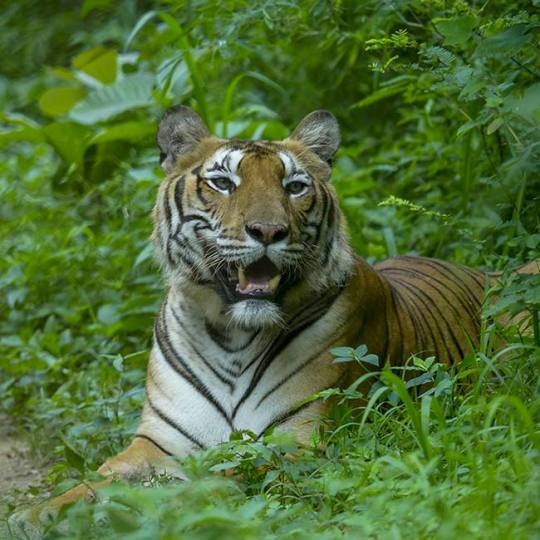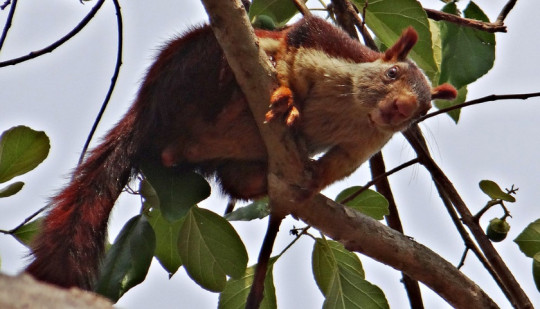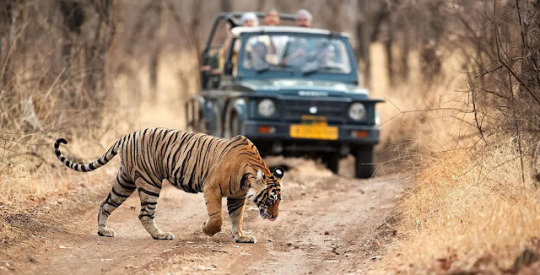#wildlife sanctuary and national park in india
Text
#ranthambore national park#ranthambore national park rajasthan#ranthambore tiger reserve sawai madhopur#ranthambore tiger reserve rajasthan#tiger reserves in india#national parks in india#wildlife sanctuary and national park in india#best tiger reserve in india#ranthambore national park tiger safari#tiger reserve in rajasthan#best national park in india
0 notes
Text

Gopal, a wild tiger roaming free in the Nagarahole National Park, was a victim of human-wildlife conflict when he developed a taste for livestock. Eventually he had to be rescued and shifted to a safe place to protect him from an angry mob. Gopal now resides in a forested enclosure at the Bannerghatta Tiger Sanctuary in Karnataka, managed by Wildlife SOS and the Born Free Foundation.
Photo by Lenu Kannan.
#lenu kannan#photographer#wildlife sos#tiger#animal#mammal#wildlife#nagarahole national park#india#bannerghatta tiger sanctuary#nature#karnataka
38 notes
·
View notes
Text
Rajasthan Wildlife Safari Tour

Rajasthan Wildlife Tour package is designed for the travellers who want to explore and feel the richness of Rajasthan's history, culture and wildlife through the monuments and by visiting the wildlife sanctuary.
Best Ranthambore Safari Booking Service
Contact us
Name: Sudhir Sharma
Website: https://www.culturalsafaritours.com
Email: [email protected]
CALL US: +91 7014717217, +91 9414030306
#Rajasthan Wildlife Tour#Wildlife Tour#famous wildlife sanctuaries in india#National Parks and Wildlife Sanctuaries in Rajasthan#Rajasthan Wildlife Safari Tour
5 notes
·
View notes
Text
India is a land of diverse landscapes and rich biodiversity. One of the best ways to experience this natural beauty is by visiting its numerous national parks. Here is the list of 30 Best National Parks in India to make your travel smooth and hassle-free.
#national parks in india#kanha tiger reserve#ranthambore national park rajasthan#tiger reserve in india#national park in madhya pradesh#difference between national park and wildlife sanctuary#total national park in india
0 notes
Text
#travel#travelling#adventure#wildlifephotography#wildlife sanctuary#wildlife safari#tiger tours india#ranthambore national park
0 notes
Text

Wildlife Vacation Tour with Nature in INDIA
National Parks and Wildlife Sanctuaries of India.
Login: https://www.southasiavoyage.com
#southasia#india#wildlife#tourism#travel#nature#forest#wild animals#tiger safari#national park#sanctuaries#resort#jungle#india tourism#tourguide#nature lovers
0 notes
Text
#Safari Tours India#National Parks India#Tiger Reserves India#Wildlife Sanctuaries#Bird Watching Tours#Jungle Safari India#Elephant Safaris#Wildlife Adventure Trips
0 notes
Text
Charting a Green Path: 2024's Sustainable Tourism at Kuno Forest Retreat
In the heart of India's vibrant landscape, nestled within the lush confines of Madhya Pradesh, lies a beacon of sustainable tourism: Kuno Forest Retreat. As we venture into 2024, this sanctuary not only promises an escape into nature but also stands as a testament to eco-friendly travel and wildlife conservation success stories.

The Kuno Wildlife Sanctuary: A Commitment to Conservation
Kuno Wildlife Sanctuary, part of the larger Madhya Pradesh National Park network, has long been at the forefront of conservation efforts in India. Its dedication to preserving the natural habitat and the species that call it home exemplifies the positive environmental impact of tourism. The sanctuary’s efforts have led to numerous wildlife conservation success stories, making it a model for sustainable tourism in India.
Sustainable Tourism in the Heart of India
Kuno Forest Retreat is more than just a destination; it's an experience that harmonizes luxury with nature's untouched beauty. In fostering sustainable tourism, the retreat has implemented practices that minimize environmental footprints while maximizing visitor engagement with the natural world. From solar energy to water conservation methods, every aspect of the retreat is designed with sustainability in mind.
Green Getaways: The Essence of Eco-Friendly Travel
2024's sustainable tourism landscape is rich with green getaways, yet Kuno Forest Retreat stands out for its commitment to eco-friendly accommodations. These accommodations not only offer comfort and luxury but also ensure that every stay contributes positively to the surrounding ecosystem. The retreat's practices exemplify how tourism can coexist with nature conservation, providing a blueprint for green travel destinations worldwide.
Exploring the Great Outdoors: Adventures in Kuno
Kuno Forest Retreat offers a plethora of activities that allow guests to immerse themselves in the majesty of Madhya Pradesh's national parks and wildlife sanctuaries. Whether it's a safari through the dense forests, a guided nature walk that reveals the secrets of the local flora and fauna, or star-gazing sessions under the clear night sky, the retreat ensures that every experience is in harmony with its sustainable tourism ethos.
The Role of Eco-Friendly Accommodations
The significance of eco-friendly accommodations in reducing the environmental impact of tourism cannot be overstated. At Kuno Forest Retreat, guests find themselves staying in settings that are not only luxurious but also environmentally conscious. From the materials used in construction to the daily operations, everything is aligned with the goal of sustainability. By choosing eco-friendly accommodations, travelers contribute to a larger movement that prioritizes the well-being of our planet.
A Beacon for Sustainable Tourism in India
Kuno Forest Retreat is not just a destination; it's a movement towards a greener future. As we look towards 2024 and beyond, the retreat's role in promoting sustainable tourism in India becomes increasingly vital. It serves as a reminder that responsible travel is not only about the places we visit but also about how we choose to engage with them.
Accommodation Details
For those planning their next sustainable getaway, Kuno Forest Retreat offers a variety of eco-friendly accommodations designed to provide an immersive experience in nature without compromising on luxury or comfort. Discover the perfect blend of wilderness and wellness by exploring our accommodation options here.
In conclusion, as we navigate the path of sustainable tourism in 2024, Kuno Forest Retreat shines as a beacon of hope and inspiration. It exemplifies how destinations can offer mesmerizing experiences while upholding the principles of conservation and sustainability. A visit to Kuno is not just a journey to a place but a step towards a more sustainable and conscious way of exploring our beautiful planet.
#kuno wildlife sanctuary#madhya pradesh national park#green getaways#sustainable tourism#sustainable tourism in india#green travel destinations#national park and wildlife sanctuary#kuno forest retreat#eco friendly accommodations#environmental impact of tourism
0 notes
Text
Top 10 National Parks You Must Visit in India
A National Park is a designated area created by the government to safeguard the natural environment, wildlife, and biodiversity. These protected areas fall under the Wildlife Protection Act of 1972, prohibiting illegal hunting, poaching, and grazing.
India has spectacular 106 national parks, each offering a unique and breathtaking experience for nature lovers. For those seeking the ultimate adventure, we have curated a list of the top 10 national parks that are truly worth visiting at least once in your lifetime.
These exceptional destinations will leave you in awe with their stunning landscapes, diverse wildlife, and unforgettable experiences.
0 notes
Text
Camera-trapping data revealed in a new study show a steady recovery of tigers in Thailand’s Western Forest Complex over the past two decades.
The tiger recovery has been mirrored by a simultaneous increase in the numbers of the tigers’ prey animals, such as sambar deer and types of wild cattle.
The authors attribute the recovery of the tigers and their prey to long-term efforts to strengthen systematic ranger patrols to control poaching as well as efforts to restore key habitats and water sources.
Experts say the lessons learnt can be applied to support tiger recovery in other parts of Thailand and underscore the importance of the core WEFCOM population as a vital source of tigers repopulating adjacent landscapes.
The tiger population density in a series of protected areas in western Thailand has more than doubled over the past two decades, according to new survey data.
Thailand is the final stronghold of the Indochinese tiger (Panthera tigris corbetti), the subspecies having been extirpated from neighboring Cambodia, Laos and Vietnam over the past decade due to poaching, habitat loss and indiscriminate snaring...
Fewer than 200 tigers are thought to remain in Thailand’s national parks and wildlife sanctuaries, only a handful of which are sufficiently undisturbed and well-protected to preserve breeding tigers.
The most important of these protected areas for tigers is the Huai Kha Khaeng Thung Yai (HKK-TY) UNESCO World Heritage Site, which comprises three distinct reserves out of the 17 that make up Thailand’s Western Forest Complex (WEFCOM). Together, these three reserves — Huai Kha Khaeng Wildlife Sanctuary, Thungyai Naresuan West and Thungyai Naresuan East — account for more than a third of the entire WEFCOM landscape.
Now, a new study published in Global Ecology and Conservation documents a steady recovery of tigers within the HKK-TY reserves since camera trap surveys began in 2007. The most recent year of surveys, which concluded in November 2023, photographed 94 individual tigers, up from 75 individuals in the previous year, and from fewer than 40 in 2007.
Healthy tiger families

The study findings reveal that the tiger population grew on average 4% per year in Hua Kha Khaeng Wildlife Sanctuary, the largest and longest-protected of the reserves, corresponding to an increase in tiger density from 1.3 tigers per 100 square kilometers, to 2.9 tigers/100 km2.
“Tiger recoveries in Southeast Asia are few, and examples such as these highlight that recoveries can be supported outside of South Asia, where most of the good news [about tigers] appears to come from,” said Abishek Harihar, tiger program director for Panthera, the global wildcat conservation organization, who was not involved in the study.
Among the camera trap footage gathered in HKK-TY over the years were encouraging scenes of healthy tiger families, including one instance of a mother tiger and her three grownup cubs lapping water and lounging in a jacuzzi-sized watering hole. The tiger family stayed by the water source for five days during the height of the dry season.
The team of researchers from Thailand’s Department of National Parks, Wildlife and Plant Conservation, the Wildlife Conservation Society, Kasetsart University, and India’s Center for Wildlife Studies deployed camera traps at more than 270 separate locations throughout the HKK-TY reserves, amassing 98,305 days’ worth of camera-trap data over the 19-year study period.
Using software that identifies individual tigers by their unique stripe patterns, they built a reference database of all known tigers frequenting the three reserves. A total of 291 individual tigers older than 1 year were recorded, as well as 67 cubs younger than 1 year [over the course of the study].
Ten of the tigers were photographed in more than one of the reserves, indicating their territories straddled the reserve boundaries. The authors conclude that each of the three reserves has a solid breeding tiger population and that, taken together, the HKK-TY landscape is a vital source of tigers that could potentially repopulate surrounding areas where they’ve been lost. This is supported by cases of known HKK-TY tigers dispersing into neighboring parts of WEFCOM and even across the border into Myanmar.
Conservation efforts pay off
Anak Pattanavibool, study co-author and Thailand country director at the Wildlife Conservation Society, told Mongabay that population models that take into account the full extent of suitable habitat available to tigers within the reserves and the likelihood that some tigers inevitably go undetected by camera surveys indicate there could be up to 140 tigers within the HKK-YT landscape.
Anak told Mongabay the tiger recovery is a clear indication that conservation efforts are starting to pay off. In particular, long-term action to strengthen systematic ranger patrols to control poaching as well as efforts to boost the tigers’ prey populations seem to be working, he said.
“Conservation success takes time. At the beginning we didn’t have much confidence that it would be possible [to recover tiger numbers], but we’ve been patient,” Anak said. For him, the turning point came in 2012, when authorities arrested and — with the aid of tiger stripe recognition software — prosecuted several tiger-poaching gangs operating in Huai Kha Khaeng. “These cases sent a strong message to poaching gangs and they stopped coming to these forests,” he said."
...ranger teams have detected no tiger poaching in the HKK-TY part of WEFCOM since 2013.
-via Mongabay News, July 17, 2024
#tigers#thailand#thai#endangered species#big cats#conservation#wildlife#wildlife conservation#wildlife photography#poaching#good news#hope
1K notes
·
View notes
Text

#ranthambore national park#ranthambore national park rajasthan#ranthambore tiger reserve sawai madhopur#ranthambore tiger reserve rajasthan#tiger reserves in india#national parks in india#wildlife sanctuary and national park in india#best tiger reserve in india#ranthambore national park tiger safari#tiger reserve in rajasthan#best national park in india
1 note
·
View note
Link

If you're a nature lover and want to experience the beauty and diversity of South India's flora and fauna, then visiting its wildlife sanctuaries and national parks is a must. From the Western Ghats to the Eastern Ghats, South India is home to a number of protected areas that are home to a wide variety of species, including tigers, elephants, leopards, and many more.
In this blog post, we'll explore the top 10 wildlife sanctuaries and national parks in South India that you should add to your travel bucket list.
Bandipur National Park: Located in the Chamarajanagar district of Karnataka, Bandipur National Park is a popular destination for both tourists and wildlife enthusiasts. The park is home to a variety of species, including tigers, elephants, gaurs, and leopards.
Read more at List of 10 Best National Parks in South India
#List of 10 Best National Parks in South India#best national parks in South India#wildlife sanctuaries in South India#South India wildlife tours#national parks in Kerala#national parks in Karnataka#national parks in Tamil Nadu#national parks in Telangana#India wildlife safaris#Indian national parks#Alkof Holidays#alkofholidays
0 notes
Text
TOP 5 NATIONAL PARKS TO VISIT IN INDIA
India is a land of diverse landscapes and rich biodiversity, making it a paradise for nature enthusiasts and wildlife lovers. The country boasts a remarkable collection of national parks and wildlife sanctuaries that house a wide range of flora and fauna. From the majestic Bengal tigers to the graceful Indian rhinoceros, these protected areas offer a glimpse into the incredible wildlife that India is home to. If you're seeking an unforgettable adventure in the lap of nature, here are the top 5 national parks in India that promise an enthralling wildlife experience. Get ready for an expedition like no other!
Jim Corbett National Park

Located in the state of Uttarakhand, the Jim Corbett National Park is India's oldest national park and a haven for wildlife enthusiasts. Named after the legendary British hunter turned conservationist, Jim Corbett, this park spans across the foothills of the Himalayas. The park is renowned for its population of the elusive Bengal tiger, making it a prime destination for tiger enthusiasts. To enhance your experience, engage in an online Jim Corbett Safari Booking, where you'll have the opportunity to explore the diverse landscapes and spot various species including leopards, elephants, and numerous bird species.
Ranthambore National Park

Situated in the royal state of Rajasthan, Ranthambore National Park is a testament to the grandeur of the Indian wilderness. Known for its historic Ranthambore Fort that stands amidst the lush forests, this park is a treasure trove of biodiversity. The park's star attraction is the majestic Bengal tiger, and Ranthambore Safari Booking provides an exhilarating chance to witness these predators in their natural habitat. With its unique blend of history and nature, Ranthambore offers an unparalleled wildlife experience.
Bandhavgarh National Park
In the heart of Madhya Pradesh lies the captivating Bandhavgarh National Park, a place where nature's beauty and wildlife's majesty converge. This park is renowned for having one of the highest densities of tigers in India. The Bandhavgarh Safari Booking allows you to traverse through dense forests, open grasslands, and serene water bodies while searching for tigers, leopards, and various deer species. The ancient Bandhavgarh Fort adds a touch of history to this natural wonderland, creating a truly unique ambiance.
Kaziranga National Park
Venture to the northeastern state of Assam, and you'll discover the UNESCO World Heritage-listed Kaziranga National Park. This park is a sanctuary for the rare and endangered Indian one-horned rhinoceros, making it a critical conservation site. The park's marshy grasslands and dense forests provide a unique habitat for various wildlife species. Engage in a Kaziranga National Park Safari Booking to witness not only the impressive rhinoceros but also wild elephants, Asiatic water buffaloes, and a plethora of bird species.
Periyar National Park
Down south in the state of Kerala, Periyar National Park offers a distinct wildlife experience amidst the Western Ghats' lush greenery. What sets this park apart is its picturesque location around the Periyar Lake, where you can enjoy a boat safari while spotting animals at the water's edge. The park is a sanctuary for various mammals, including the endangered Nilgiri tahr and the elusive Indian wild dog. A Periyar National Park Safari Booking lets you explore the park's unique ecosystem while cruising through its tranquil waters.
Conclusion
Embarking on an India wildlife tour to these top 5 national parks promises an adventure of a lifetime. From the royal Bengal tigers of Ranthambore to the rare Indian rhinoceros of Kaziranga, each park offers a unique opportunity to connect with nature's wonders. Engage in Jim Corbett Safari Booking, Ranthambore Safari Booking, Bandhavgarh Safari Booking, Kaziranga National Park Safari Booking, and Periyar National Park Safari Booking to fully immerse yourself in the beauty and diversity of India's wildlife. These national parks not only showcase the splendor of the country's natural heritage but also play a crucial role in conserving its precious flora and fauna. So, gear up for a wild adventure and let India's national parks leave an indelible mark on your soul.
0 notes
Text
youtube
#National Parks & Sanctuaries | Geography Live Session | Crash Course | TOne Academy#This live session deals with#• Wildlife Sanctuaries#• Differences between National Parks and Wildlife Sanctuaries#• Bird Sanctuaries#Animal Sanctuaries#- National parks of India#- National parks in two Telugu States#- Definition of National Park#WildlifeSanctuaries#BirdSanctuaries#AnimalSanctuaries#NationalParks#largestsanctuary#smallestsanctuary#KutchDesertSanctuary#RoweIsland#NationalPark#LargestNationalPark#SmallestNationalPark#InternationalUnionforConservationofNationalParks#CorbettNationalPark#For any queries/doubts/information - we are just an email away - mail us @ [email protected]#Subscribe to : https://bit.ly/2YQOgbs#toneacademy#tspsc#previousyearpaper#Youtube
0 notes
Text
Rani Tal, located in Himachal Pradesh, India, is a beautiful lake that attracts visitors with its serene and picturesque surroundings. This tranquil spot is perfect for those looking to escape the hustle and bustle of city life and enjoy nature's beauty. Surrounded by lush greenery and offering stunning views, Rani Tal provides a peaceful retreat for picnicking, boating, and leisurely walks. The area also offers several offbeat places near Chail, making it an appealing destination for travelers seeking hidden gems and unique experiences.

For those exploring places to visit near Rani Tal, the Bhimakali Temple is a must-see. This ancient temple, dedicated to Goddess Bhimakali, showcases unique architecture and holds significant religious importance. Visitors can admire the intricate carvings and enjoy the serene atmosphere of the temple. Another nearby attraction is the Solan Brewery, one of the oldest breweries in India. Here, visitors can learn about the brewing process and sample some of the local brews, making for an interesting and enjoyable experience.
Another delightful destination near Rani Tal is the Mohan Shakti National Heritage Park. This expansive park features beautifully crafted sculptures, temples, and gardens that reflect India's rich cultural heritage. It offers a peaceful environment for leisurely strolls and photography. For those interested in exploring more places to visit near Rani Tal, the nearby Chail Sanctuary provides an opportunity to witness diverse wildlife and enjoy nature walks in a pristine setting, making Rani Tal a perfect base for discovering the natural and cultural treasures of Himachal Pradesh.
#clearholidays#Rani Tal#places to visit near Rani Tal#Rani Tal tourism#Rani Tal travel guide#himachal pradesh#india#india travel#india tourism#incredible india
3 notes
·
View notes